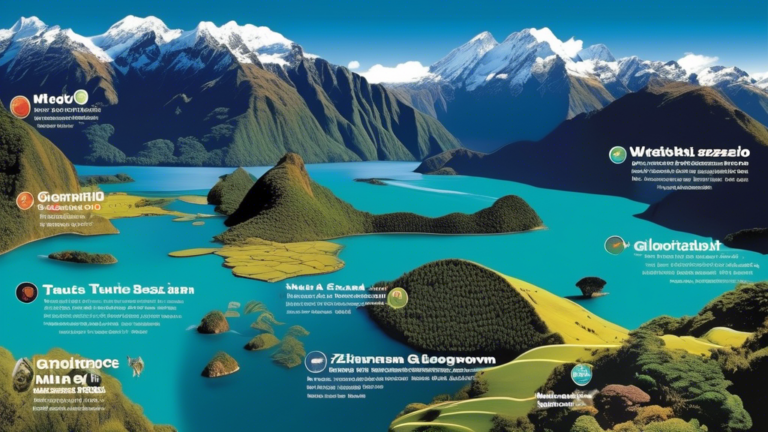Antarctica is a fascinating and mysterious continent that is known for its extreme conditions and unique wildlife. This icy landmass holds many secrets and surprises, making it a topic of great interest for adventurers, scientists, and nature enthusiasts alike. Get ready to explore the wonders of Antarctica and uncover some intriguing facts about this frozen land.
More About World&History
Key Takeaways:
- Antarctica is the highest, driest, coldest, and windiest continent on Earth.
- It holds most of the world’s fresh water, with 60-90% of the world’s fresh water locked in its vast ice sheet.
- Antarctica used to be much warmer, with temperatures reaching up to 17°C and lush green forests covering the land.
- There is no permanent population in Antarctica, and it is governed by the Antarctic Treaty system.
- Antarctica is home to active volcanoes, including Mount Erebus, the southernmost active volcano on Earth.
These are just a few of the exciting facts about Antarctica. Continue reading to delve deeper into the extreme climate, historical changes, diverse wildlife, and environmental protection of this awe-inspiring continent.
Antarctica’s Extreme Conditions
Antarctica is the highest, driest, coldest, and windiest continent on Earth, with vast ice sheets covering most of its 14.2 million square kilometers. Its extreme conditions make it one of the most challenging environments on the planet.
With temperatures dropping as low as -89.2°C (-128.6°F), Antarctica holds the record for the coldest temperature ever recorded on Earth. The extraordinary cold is due to its location at the South Pole, where the continent is surrounded by the Southern Ocean and isolated from warm ocean currents.
Not only is Antarctica cold, but it is also incredibly dry. The polar desert receives very little precipitation, with the average annual rainfall at the South Pole measuring just over 10 mm. The dryness, combined with freezing temperatures, creates a unique landscape characterized by vast expanses of ice and snow.
The extreme conditions in Antarctica also result in powerful winds. The continent experiences frequent blizzards and storms, with wind speeds reaching over 322 km/h (200 mph). These strong winds shape the landscape, sculpting ice formations and creating breathtaking vistas.
A Visual Representation of Antarctica’s Extreme Conditions
Take a look at this image that encapsulates the extreme conditions of Antarctica:

| Extreme Conditions in Antarctica | Measurement |
|---|---|
| Coldest Temperature Recorded | -89.2°C (-128.6°F) |
| Average Annual Rainfall | 10 mm |
| Wind Speeds | Up to 322 km/h (200 mph) |
Antarctica’s extreme conditions make it a captivating and challenging destination for explorers and scientists alike. Its unique climate and geography contribute to its enigmatic allure, making it an extraordinary place to study and discover.
The Abundance of Freshwater in Antarctica
Antarctica holds the majority of the world’s fresh water, with 60-90% locked in its vast ice sheet. This frozen reservoir is truly impressive, storing an estimated 26.5 million cubic kilometers of water. To put that into perspective, if all the ice were to melt, it would raise global sea levels by about 60 meters, submerging many coastal areas.
Did you know? The Antarctic ice sheet is about 4.8 kilometers thick on average and covers an area of approximately 14 million square kilometers. It’s the largest single mass of ice on Earth and acts as a vital regulator of the planet’s climate.
The ice sheet also plays a critical role in maintaining the stability of the Antarctic ecosystems. It provides habitats for unique ice-adapted organisms and supports a complex food web, from microscopic algae to large marine mammals.
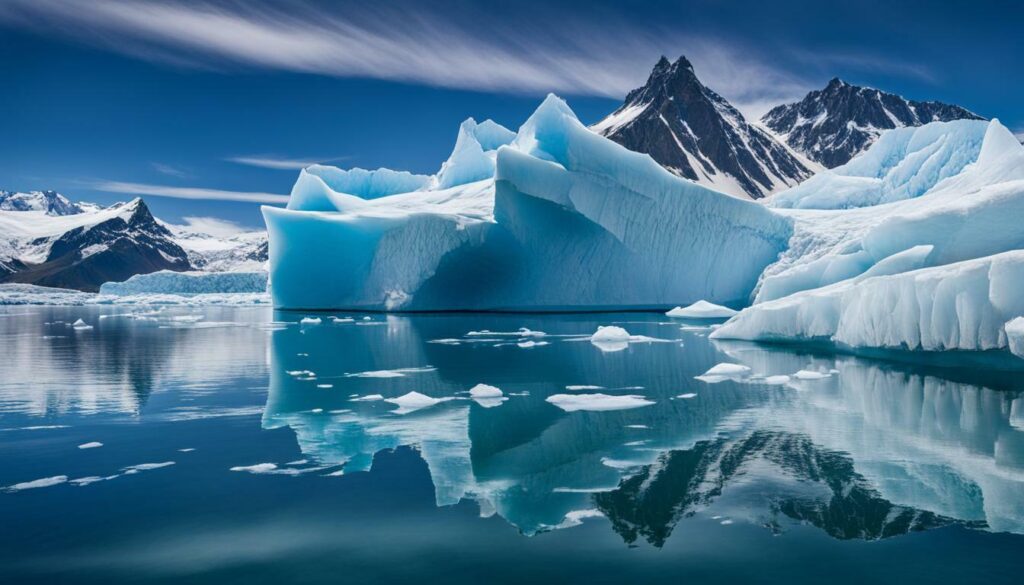
The vastness of Antarctica’s freshwater resources has piqued the interest of scientists and researchers. They study the ice cores extracted from the ice sheet to learn more about the Earth’s climate history, atmospheric conditions, and even search for signs of ancient life.
Fun Fact: Antarctica’s ice cores can contain valuable information dating back hundreds of thousands of years, allowing scientists to unravel the mysteries of our planet’s past and gain insights into future climate change.
The Importance of Preserving Antarctica’s Freshwater
Preserving Antarctica’s freshwater resources is crucial not only for scientific research but also for the global ecosystem. The stability of the ice sheet directly impacts sea levels and ocean currents, which in turn influence weather patterns around the world.
The Antarctic Treaty, signed in 1959, recognizes the significance of protecting Antarctica’s environment and designates the continent as a natural reserve dedicated to peaceful scientific research. It prohibits any commercial exploitation, including mining or mineral exploration, to prevent irreversible damage to this pristine environment.
| Fact | Antarctica’s Freshwater Reservoir |
|---|---|
| Estimated Freshwater Volume | 26.5 million cubic kilometers |
| Potential Sea Level Rise | About 60 meters if all ice melted |
| Average Ice Sheet Thickness | Approximately 4.8 kilometers |
| Total Ice Sheet Area | Approximately 14 million square kilometers |
As the world faces the challenges of climate change, understanding and protecting Antarctica’s freshwater resources has become increasingly important. By safeguarding this precious reserve, we can ensure the long-term stability of our planet’s delicate balance.
Discover Antarctica on Google Maps
Antarctica’s Historical Climate Changes
Antarctica used to have much milder temperatures, with forests and dinosaurs inhabiting the continent around 40-50 million years ago. It’s hard to imagine, but this frozen landscape was once a lush and vibrant environment. The evidence of this ancient climate can be found in the fossilized remains of plant and animal species that once thrived here.
Scientists have studied sediment cores drilled from the ocean floor surrounding Antarctica to reconstruct the continent’s past climate. These cores contain layers of sediment made up of microscopic fossils and other indicators of past environmental conditions. By analyzing these layers, researchers have discovered that Antarctica transitioned from a warmer, forested environment to the icy wilderness we know today.
The climate change in Antarctica can be attributed to a variety of factors, including shifts in Earth’s orbit and changes in the distribution of landmasses. During periods of warmer climate, Antarctica was connected to other landmasses, allowing for the exchange of plant and animal species. As the continent drifted south, it became isolated, and the cooling effect of ocean currents around Antarctica led to the formation of ice sheets.
This dramatic shift in climate has had a profound impact on the planet. Antarctica’s ice has preserved a record of Earth’s past climate, providing invaluable insights into how our planet has changed over millions of years. Understanding these historical climate changes is crucial for predicting future climate trends and developing strategies to mitigate the effects of global warming.
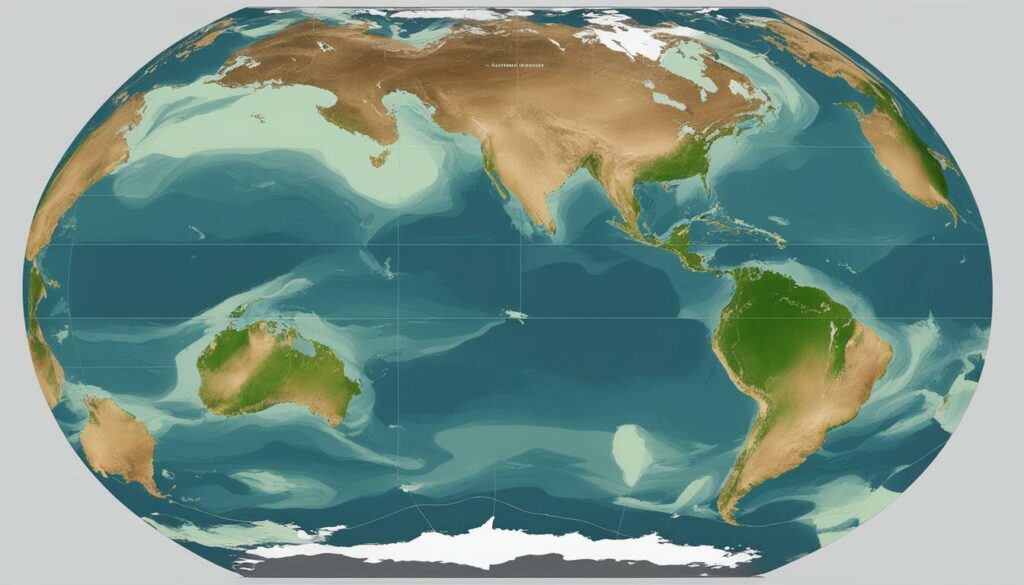
- Antarctica used to have a milder climate, with forests and dinosaurs present around 40-50 million years ago.
- Sediment cores from the ocean floor have provided evidence of past climate conditions in Antarctica.
- Changes in Earth’s orbit and the continent’s isolation led to the formation of ice sheets.
- Antarctica’s historical climate changes provide valuable insights into Earth’s past and future climate trends.
Antarctica’s climate history is a testament to the dynamic nature of our planet and serves as a reminder of the importance of preserving and protecting this unique and fragile ecosystem.
| Antarctica’s Historical Climate Changes | Key Points |
|---|---|
| Antarctica used to have a milder climate, with forests and dinosaurs present around 40-50 million years ago. | • Antarctica used to have much milder temperatures, with forests and dinosaurs inhabiting the continent around 40-50 million years ago. |
| Sediment cores from the ocean floor have provided evidence of past climate conditions in Antarctica. | • Scientists have studied sediment cores drilled from the ocean floor surrounding Antarctica to reconstruct the continent’s past climate. |
| Changes in Earth’s orbit and the continent’s isolation led to the formation of ice sheets. | • The climate change in Antarctica can be attributed to a variety of factors, including shifts in Earth’s orbit and changes in the distribution of landmasses. |
| Antarctica’s historical climate changes provide valuable insights into Earth’s past and future climate trends. | • Understanding these historical climate changes is crucial for predicting future climate trends and developing strategies to mitigate the effects of global warming. |
Governance and Population of Antarctica
Antarctica has no permanent population and is governed by the Antarctic Treaty system, which prohibits any country from owning the continent. This unique international agreement, signed in 1959, ensures that Antarctica is dedicated to peaceful research activities and environmental protection. The treaty has been ratified by 54 countries, including the United States, Russia, and the United Kingdom, making it one of the most successful cooperative agreements in history.
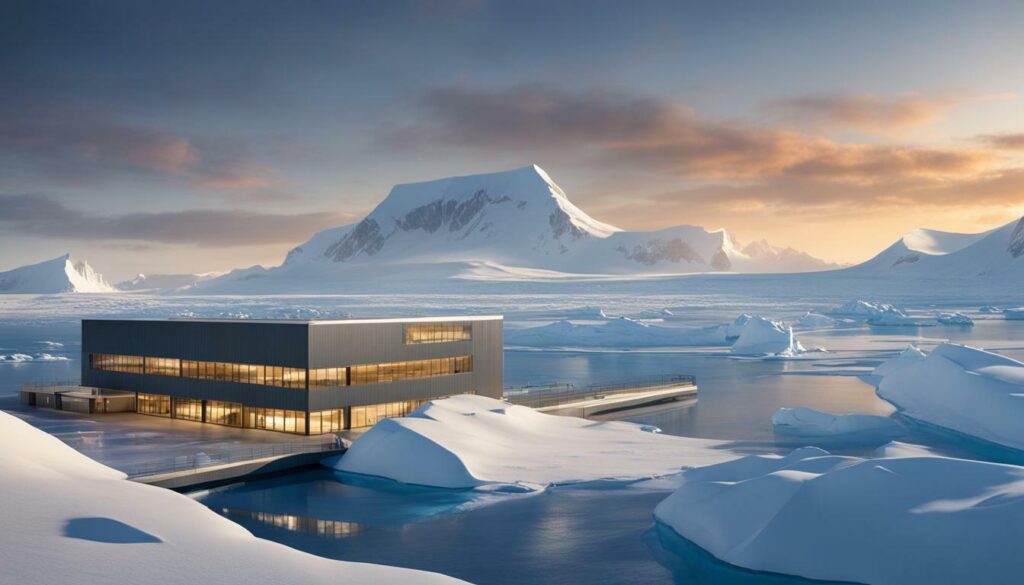
The governance of Antarctica is overseen by the Antarctic Treaty Secretariat, which promotes adherence to the treaty’s principles and coordinates the activities of member nations. The treaty sets forth guidelines for the conservation of flora and fauna, the protection of historical sites, and the regulation of tourism. It also prohibits any military activity, nuclear testing, and the exploitation of mineral resources. This commitment to environmental protection ensures that Antarctica remains one of the world’s last untouched wildernesses.
While there is no permanent population in Antarctica, it is not entirely uninhabited. The continent is home to numerous research stations operated by various countries, where scientists and support staff work on a rotational basis. These researchers conduct vital studies on climate change, geology, biology, and astrophysics, contributing to our understanding of the planet and the universe. They brave the harsh conditions of Antarctica, enduring freezing temperatures, hurricane-force winds, and months of darkness, to unlock the secrets of this frozen wilderness.
Research Stations in Antarctica
| Country | Research Stations |
|---|---|
| United States | McMurdo Station, Amundsen-Scott South Pole Station |
| Russia | Vostok Station, Mirny Station |
| United Kingdom | Rothera Research Station, Halley Research Station |
| China | Great Wall Station, Zhongshan Station |
| Germany | Neumayer-Station III |
These research stations serve as hubs for scientific discovery and collaboration, allowing researchers from around the world to study the unique environment of Antarctica. From climate change to space exploration, these dedicated individuals are at the forefront of scientific advancements, pushing the boundaries of human knowledge.
Volcanoes in Antarctica
Antarctica is home to several active volcanoes, with Mount Erebus being the southernmost active volcano on Earth. This majestic volcano, located on Ross Island, stands at a towering 3,794 meters and produces a constant plume of steam and gases, creating a captivating sight in the otherwise icy landscape. Mount Erebus is one of the few volcanoes in the world with a persistent lava lake, making it a subject of great scientific interest.
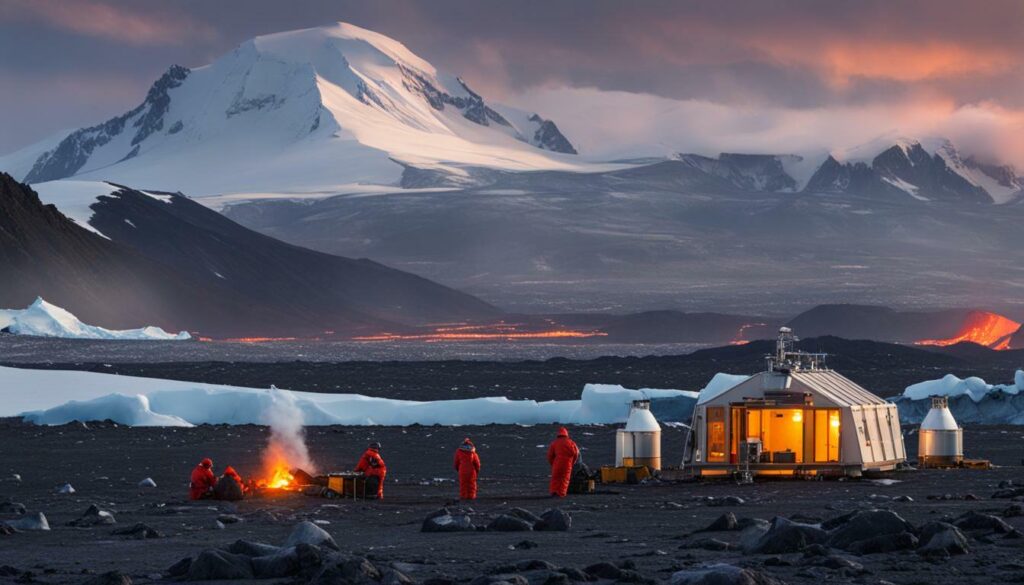
Aside from Mount Erebus, Antarctica boasts other volcanic peaks, such as Mount Melbourne, Deception Island, and Mount Discovery. These volcanoes, although less famous, contribute to the geological diversity and dynamism of the continent. Their eruptions can have significant impacts on local climate, ice dynamics, and biological communities in the surrounding areas.
The presence of volcanoes in Antarctica also presents a unique opportunity for scientific exploration and research. The volcanoes offer a window into the Earth’s mantle and provide valuable insights into the planet’s geologic processes. Scientists study the volcanic activity and its effects on the ice sheet to better understand the interplay between geology, climate, and the stability of Antarctica’s ice.
While the volcanoes of Antarctica are awe-inspiring, they also serve as a reminder of the dynamic nature and hidden wonders of this remote continent. As research continues, we can expect to uncover more about the mysteries and geological marvels that lie beneath the icy surface of Antarctica.
Antarctica’s Environmental Protection
Antarctica has its own treaty that dedicates the continent to peaceful research activities and prohibits mining or mineral exploration. Known as the Antarctic Treaty, it was signed in 1959 by 12 countries and has been ratified by 54 countries to date. The treaty sets forth guidelines and principles for the protection of Antarctica’s unique environment and ensures that it remains a place of scientific research and cooperation.
The primary objective of the Antarctic Treaty is to preserve the pristine nature of Antarctica and promote international cooperation in scientific research. It prohibits any activity relating to mineral resources, such as mining, as well as military activities and nuclear testing. The treaty also prohibits any territorial claims while allowing freedom of scientific investigation and exchange of research findings.
This commitment to environmental protection has made Antarctica a haven for scientific research. It has fostered international collaboration in various scientific disciplines, including climate research, geology, marine biology, and astrophysics. Scientists from around the world come together to study the continent’s unique ecosystem and better understand the impacts of climate change on the region and the planet as a whole.
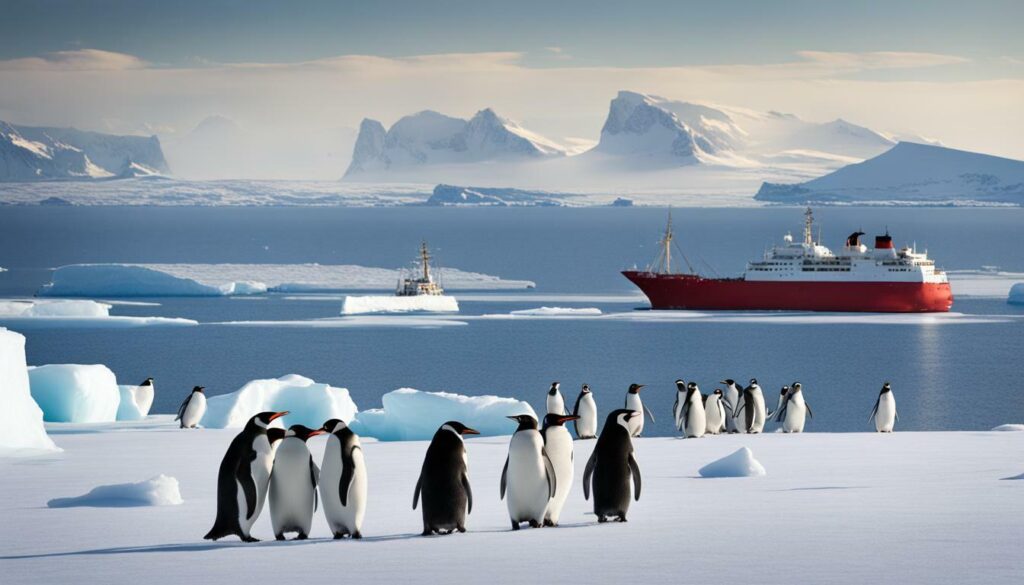
The Antarctic Treaty is regularly reviewed and updated through meetings of the Consultative Parties, which are the countries involved in scientific research in Antarctica. These meetings ensure that the treaty remains relevant and effective in addressing emerging environmental challenges. The commitment to protecting Antarctica’s delicate ecosystem has also led to the designation of several protected areas, such as the Antarctic Specially Protected Areas (ASPAs) and Antarctic Specially Managed Areas (ASMAs), which are aimed at conserving unique habitats and species.
In summary, the Antarctic Treaty plays a crucial role in safeguarding Antarctica’s environment and promoting scientific research. By dedicating the continent to peaceful activities and prohibiting mining or mineral exploration, it ensures the preservation of this pristine and extraordinary region for future generations.
Warming Trends in Antarctica
Antarctica is experiencing rapid warming, with temperatures on the Antarctic Peninsula increasing by 3°C in the past 50 years. This warming trend is causing significant changes in the continent’s climate and environment. The melting of ice sheets and glaciers has accelerated, leading to rising sea levels and posing a threat to coastal regions around the world.
The impacts of climate change in Antarctica are far-reaching. The delicate balance of the ecosystem is being disrupted, affecting the diverse wildlife that calls Antarctica home. Penguins, whales, seals, and birds all depend on the frozen environment for their survival. Increased temperatures and loss of sea ice have a direct impact on their food sources and breeding patterns.
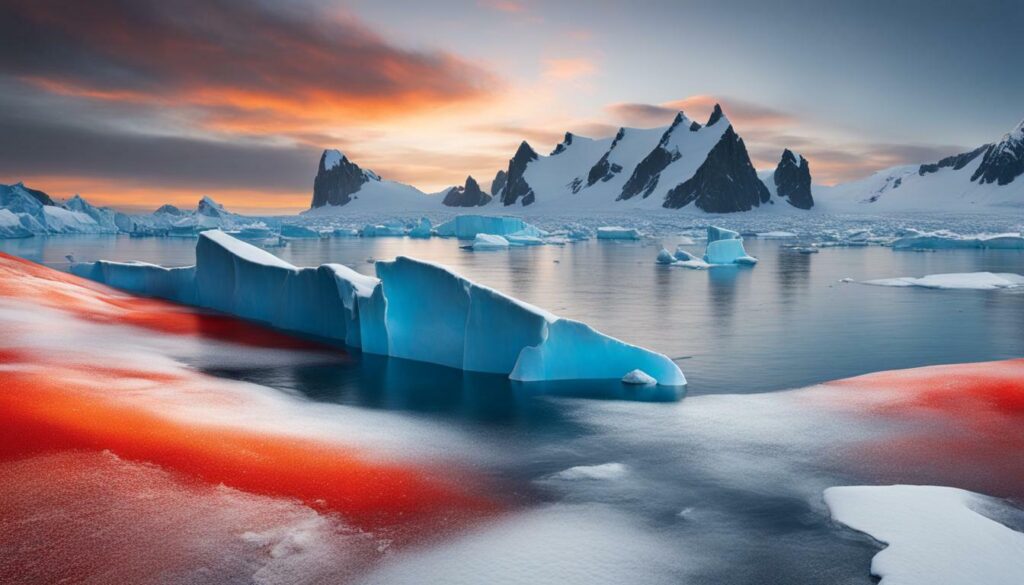
Scientists are closely monitoring the warming trends in Antarctica to better understand the implications for the planet. Research expeditions and studies are conducted to gather data on ice melting, ocean currents, and wildlife populations. This information is crucial for developing effective strategies to mitigate the effects of climate change and protect Antarctica’s unique ecosystem.
The warming trends in Antarctica are a clear indication of the global climate crisis we are facing. It serves as a reminder of the urgent need to take collective action to reduce greenhouse gas emissions and implement sustainable practices. The fate of Antarctica and its wildlife is intricately connected to the well-being of our planet, and it is our responsibility to preserve this pristine wilderness for future generations.
Diverse Wildlife of Antarctica
Antarctica is home to a variety of wildlife, including penguins, whales, seals, and numerous species of birds. The frigid waters surrounding the continent are teeming with life, making it a unique and vibrant ecosystem.
One of the most iconic creatures of Antarctica is the penguin. These adorable flightless birds have adapted to thrive in the harsh conditions, with species such as the Emperor Penguin and Adélie Penguin being well-known inhabitants of the continent. They spend their lives on the icy shores, waddling along and diving into the freezing waters in search of their fishy meals.
Whales are another majestic sight in Antarctica. These gentle giants migrate to the Southern Ocean to feed on the abundance of krill and other small marine organisms. The waters are visited by several species, including humpback whales, orcas, and minke whales. Witnessing these magnificent creatures breach the surface is an awe-inspiring experience.
The seals of Antarctica also play a vital role in the ecosystem. They use the ice as a platform for breeding and raising their young. Species like the Weddell seal and the leopard seal can be found lounging on the ice floes, while the crabeater seal, despite its name, feeds on krill. These seals are well-adapted to the freezing temperatures and are a common sight along the Antarctic coastline.
Species of Birds in Antarctica
Besides penguins, there are several species of birds that call Antarctica their home. The South Polar Skua, Antarctic Petrel, and Snow Petrel are just a few examples. These birds have evolved unique adaptations to survive in the extreme cold, including thick plumage and specialized beaks for feeding on marine life.
To get a closer look at the fascinating wildlife of Antarctica, many tourists embark on cruises or join scientific expeditions. It provides a once-in-a-lifetime opportunity to observe these incredible creatures in their natural habitat. The Southern Ocean surrounding Antarctica is a rich feeding ground and supports a diverse ecosystem that is crucial to the balance of our planet’s marine life.
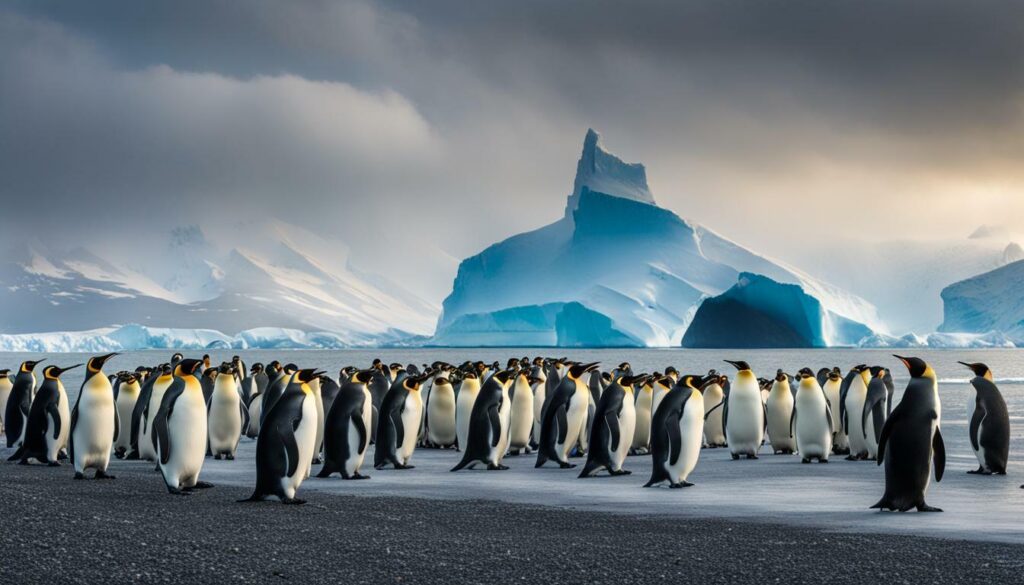
Conclusion
Antarctica continues to captivate the imaginations of adventurers and scientists alike with its extreme conditions, unique wildlife, and rich history. This mesmerizing continent, known as the highest, driest, coldest, and windiest place on Earth, covers a vast expanse of 14.2 million square kilometers, mostly engulfed in ice. However, beyond its icy facade lies a treasure trove of fascinating facts that make Antarctica truly exceptional.
One of the most remarkable features of Antarctica is its status as the holder of the majority of the world’s fresh water. With 60-90% of the planet’s freshwater stored in its massive ice sheet, Antarctica plays a critical role in global water resources. The significance of this cannot be overstated, as if all the ice were to melt, it would cause a staggering 60-meter rise in global sea levels.
Despite its seemingly barren landscape, Antarctica is considered a desert due to its minimal precipitation. The South Pole, with an average rainfall of just over 10 mm per year, exemplifies the continent’s arid conditions. However, the stark contrast between its current climate and its past is truly astonishing. Over 40-50 million years ago, Antarctica was a lush haven, with temperatures reaching up to 17°C, adorned with verdant forests and inhabited by dinosaurs.
Today, Antarctica stands as a testament to international cooperation and scientific exploration. Governed by the Antarctic Treaty system, this remarkable continent belongs to no single nation and prohibits any form of ownership. Instead, it serves as a sanctuary for peaceful research activities, safeguarding the delicate balance of its ecosystem and preventing any mining or mineral exploration.
Antarctica’s allure extends beyond its icy exterior. Within its borders lie a number of active volcanoes, including Mount Erebus, the southernmost active volcano on Earth. These geological wonders add an enigmatic element to the already captivating landscape.
As we delve into the depths of Antarctica’s mysteries, we witness the effects of climate change. Rapid warming, particularly on the Antarctic Peninsula, has led to a temperature increase of 3°C in the past 50 years. This warming trend poses significant challenges to the delicate ecosystems and the unique wildlife that call Antarctica home.
Speaking of wildlife, Antarctica boasts an impressive array of species, with penguins, whales, seals, and a myriad of bird species gracing its icy shores. The Southern Ocean that surrounds the continent serves as a thriving feeding ground for these incredible creatures, making this remote wilderness a true haven for biodiversity.
In conclusion, Antarctica stands as a captivating testament to the wonders of our planet. Its extreme conditions, unique wildlife, rich history, and international governance make it a truly extraordinary place. As adventurers and scientists continue to explore this enigmatic continent, it is certain that Antarctica will continue to captivate the imaginations of those who seek to uncover its secrets and unravel its mysteries.
FAQ
Q: What makes Antarctica unique?
A: Antarctica is the highest, driest, coldest, and windiest continent on Earth. It is mostly covered in ice and holds the majority of the world’s fresh water.
Q: How much fresh water is stored in Antarctica?
A: Antarctica holds 60-90% of the world’s fresh water, with most of it locked in its vast ice sheet. If all the ice melted, global sea levels would rise about 60 meters.
Q: Is Antarctica a desert?
A: Yes, Antarctica is considered a desert because it receives very little precipitation. The average annual rainfall at the South Pole is just over 10 mm.
Q: What was Antarctica like in the past?
A: Antarctica used to be much warmer, with temperatures reaching up to 17°C 40-50 million years ago. It was covered in green forests and inhabited by dinosaurs.
Q: Is there a permanent population in Antarctica?
A: No, there is no permanent population in Antarctica. It is governed by the Antarctic Treaty system, which prohibits any country from owning the continent.
Q: Are there volcanoes in Antarctica?
A: Yes, Antarctica is home to many active volcanoes, including Mount Erebus, the southernmost active volcano on Earth.
Q: Can mining or mineral exploration take place in Antarctica?
A: No, the Antarctic Treaty signed in 1959 prohibits mining or mineral exploration in Antarctica. The continent is dedicated to peaceful research activities.
Q: Is Antarctica warming?
A: Yes, Antarctica is experiencing rapid warming, especially on the Antarctic Peninsula, where temperatures have increased by 3°C in the past 50 years.
Q: What is the largest iceberg ever measured in Antarctica?
A: The largest iceberg ever measured, called B-15, broke away from the Ross Ice Shelf in 2000. It was 170 miles long and 25 miles wide.
Q: What kind of wildlife can be found in Antarctica?
A: Antarctica is home to a diverse range of wildlife, including penguins, whales, seals, and numerous species of birds. The Southern Ocean surrounding Antarctica is a rich feeding ground for many marine animals.



